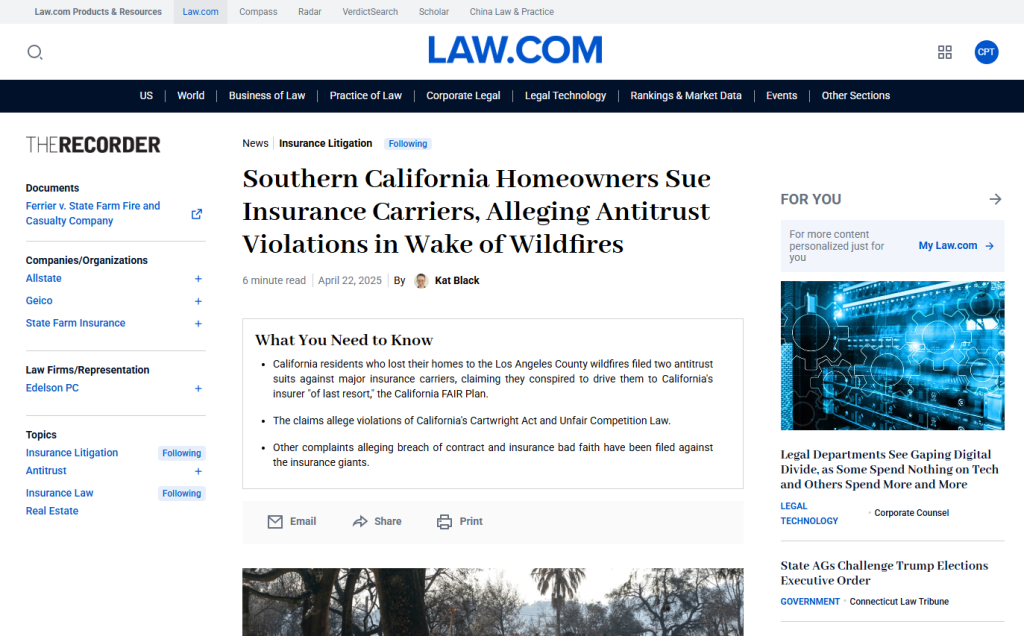Law.com is set to unveil a comprehensive redesign on June 16 that significantly restructures how legal professionals access and navigate the platform’s extensive collection of legal news and resources.
Most notably, the site is moving away from a somewhat siloed organizational structure built around the various publications owned by ALM, its parent company, in favor of an integrated, cross-publication approach organized around six core pillars of content.
Although ALM publishes a number of regional and national titles such as American Lawyer, Corporate Counsel, New York Law Journal, and others, its newsroom has, since 2024, been organized around these six pillars: business of law, practice of law, corporate legal, legal technology, U.S. news and world news.
Now, those six pillars will form Law.com’s primary organizational structure, including in a new navigation bar across the top of the page, in which those six pillars will be the main navigational elements, along with two others: “rankings and market data” and “events.”
“This new release of the upgraded Law.com experience to me really signifies more than just technical upgrades, but a reorientation of how we position our content to our readers in what we think is a smarter, more intuitive way and in a way that better maps to the way the global legal scene is operating and where folks need to get their news and information from,” Gina Passarella, senior vice president for content at ALM, told me during a preview of the new site.
“This does what we’ve been working towards for several years, which is really showcase that Law.com is the place where you can get all of your legal news, regardless of what publication it originates from or what tool you might find it in.”
‘Cohesive Global Perspective’
As part of this content reorganization, Law.com will now integrate international legal news alongside U.S. news. Previously, Law.com International operated as a separate experience that users had to navigate to through a distinct menu system. The new design places U.S. and world news side-by-side, creating what the company says will be a “cohesive global perspective.”
The change acknowledges the increasingly international nature of legal practice, where even regional firms often need awareness of global developments that could affect their clients or practice areas, Passarella said.

When viewing an article, the left rail provides links to related documents, topics, companies and law firms, making it easy to go deeper or follow a topic.
“So few people can only read one regional publication for all their legal needs,” she said. “Everybody’s practices are national or global in many respects and they need to know the business of law trends from all over the world.”
At the same time, the integration of global content is not at the expense of local and regional content, Chris Plapp, vice president for Law.com at ALM, told me during the preview. “If you are a local New York firm, you can still get right to your New York Law Journal content. We’ve streamlined that whole experience.”
“This is still all powered by the same journalists, the same brands, in the same communities that they’re very closely covering,” added Passarella. “It’s not a content strategy shift or a move away from the markets that we’ve always covered closely. It’s just bucketing it in ways that we think is a bit more intuitive.”
Modern, Mobile Friendly UI
While the redesign is — as Passarella said — about more than just technical upgrades, the technical upgrades are nonetheless substantial, based on what I saw during the demonstration. Most notably, the site’s user interface and navigation are being modernized to make them more intuitive and streamlined. The goal, Plapp said, is to minimize clicks and time spent searching in favor of enabling users to focus on key content.
For example, that navigation bar I mentioned is now sticky, meaning it remains visible even as you scroll down the page or as you read an article. Simply mouse over it to expand the navigation options.
In addition, the entire site has been rebuilt to be mobile responsive, with dedicated mobile interfaces that eliminate the need for a separate native app. The new design features a sticky top navigation that remains visible as users scroll through articles, ensuring key menu options are always accessible.
Eventually, the same navigation bar will appear across all ALM products, including Compass and Radar, with the goal of creating a more integrated user experience.
New Options for Personalization
The redesign places heavy emphasis on personalization, particularly through an expanded “For You” section that appears on the home page and elsewhere throughout the site. Users can more easily follow specific topics, regions, law firms, and companies, with this information driving a custom homepage experience, personalized daily digest alerts, and targeted content recommendations.
The platform now includes numerous opportunities to follow content, with follow buttons and plus signs distributed throughout article pages and topic sections. When users follow a topic or entity, it automatically populates their personalized feed and can trigger customized email alerts.
The redesign also enhances integration with other ALM products, specifically data-driven products such as Law.com Compass, Radar and jury verdicts. Article pages now feature a new left rail that embeds relevant court documents from Radar and law firm profile information from Compass directly into news stories.
This integration means readers can access supporting documents and additional context without leaving the article they’re reading. The goal, according to company executives, is to eventually allow users to view full court documents and detailed firm profiles without being redirected to separate platforms.
Better Search, Including Archives
The new site introduces what Law.com calls a “federated search experience” that simultaneously searches across news content, Radar court documents, Compass law firm data, case digest materials, and legal reference books. Results are organized by content type, with enhanced features like hit highlighting and content snippets to help users quickly identify relevant information.
Significantly, Law.com is reclaiming control of its archived content, which for many years it has exclusively licensed to LexisNexis and Bloomberg. These licensing agreements expire at the end of this year, and beginning in January 2026, Law.com will offer exclusive access to approximately 42 years of archived content through a new NewsVault subscription service.
The redesign updates not just the core Law.com site, but also the related (and pricier) Law.com Pro and Pro Mid-Market, which serve subscribers seeking premium content and analysis. These sections receive new curated homepages with exclusive content, enhanced briefings access, and improved integration with Compass reports.
Law.com’s newsletters are also being enhanced with personalization features. The Law.com morning and afternoon updates will now incorporate up to two regions and three topics based on user preferences. At the same time, some of the region-specific newsletters are being eliminated, reducing the total number of newsletter options.
No Change to Subscriptions
Despite the extensive redesign, the basic subscription structure remains intact. The core Law.com subscription continues as before, with separate subscriptions still required for international content, Compass, Radar, and other specialized products.
When it launches its NewsVault archive next year, the company will also offer a new subscription option for a bundled research suite. That will include the archive together with Law.com, Radar, Compass, and state access bundled into a single offering.
The new site will provide better transparency about subscription access, with a tools menu that will indicate what features users can access based on their subscription level. Grayed-out content and lock icons will be used to show restricted content.
Come June 16 and the transition to the new site, all users — including existing subscribers — will be required to go through an onboarding process. This is to ensure that the site’s content is tailored to the user’s interests. Existing subscribers will be asked to confirm or edit the regions and interests they’ve already identified, while new subscribers will be asked to select their interests.
The Bottom Line
The June 16 launch represents what the company’s executives described as phase one of a broader transformation. Plans for the remainder of 2025 include implementing a tabbed search interface, adding event management features to the MyLaw section, and further enhancing the integration between Law.com and other ALM products.
In my opinion, the redesign is in keeping with broader trends in legal information. Legal professionals increasingly want greater personalization and greater integration across multiple types and sources of content, rather than have to navigate separate platforms for news, court documents, firm intelligence, and reference materials.
By organizing more around user needs and interests rather than traditional publication or even geographic boundaries, Law.com is reflecting how legal professionals actually work in an ever-more connected and global legal marketplace.
You can read more about the “new Law.com” at this page.
 Robert Ambrogi Blog
Robert Ambrogi Blog